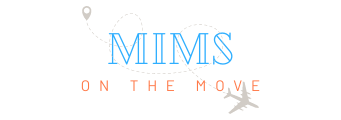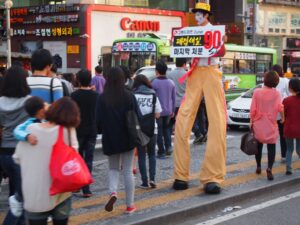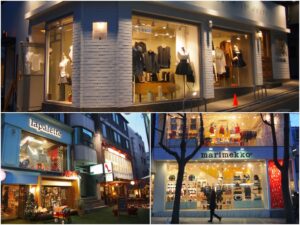Over the past decade, Hongdae has garnered the reputation of being Seoul’s SoHo, lessening Hyehwa to a mere a notch in the history of the city’s culture boom. Today, it remains off the radar to most tourists and is even overlooked by locals. Nevertheless, it remains to thrive as Seoul’s theater district- with over 80 independent theaters showing performances on a daily basis- and is brimming with diverse, inexpensive eateries, eye-catching cafes and greenspaces to boot. The neighborhood, while seemingly typical on the surface, is one of surprises. It just takes a bit of digging to discover them.
Caffeine is an essential component to the start of any day and the best place to get it in Hyehwa is b2project. Part cafe, part gallery, this cozy space is a haven for both coffee lovers and design aficionados. Enter the first floor, place your beverage order and take in the cafe’s tasteful decor. Colorful paintings adorn the walls and quirky lighting fixtures hang from above, while miss-matched chairs and tables create a comfortable environment for studying or reading a book. Before you go, take a look at the gallery downstairs, which features an array of modern Scandinavian furniture. If you’ve got money to burn, you can purchase the wares on display, which start at a whopping one million won ($1,000USD).
Now that you’re properly energized, follow the signs up the hills to Naksan Park, one of my favorite places to get a bit of fresh air in the city. The park itself offers some incredible views of downtown Seoul from the city’s fortress wall, but the real highlight is the collection of sculptures and murals that decorate its paths that wind into the low-income residential area of Ihwa-dong.
The urban art, a beautification initiative of the Ministry of Culture and Tourism, is unique in that rather than being a contrast to the dilapidated buildings that line the streets, it blends so that it appears as if the installations and paintings are at one with the spots they occupy. In my opinion, the decrepit characteristics combined with the personalized art make this part of the area far more charming than the affluent but sterile neighborhoods south of the river.
Wind your way back down to Hyehwa Station for lunch. Hidden on a side street in a renovated hanok is Zzimmani. This quaint yet modern restaurant serves up tasty Korean fare and offers some fantastic lunch specials. Everything on the menu is good but the moksal barbecue deopab (BBQ rice bowl), a mound of steamed rice covered in juicy, charcoaly meat and greens, keeps me going back on every visit to the area. The entrees are served with loads of fresh unlimited banchan (side dishes), which include a chicken salad, atypical of a Korean spread. An added bonus is the ridiculously cheap price: each set costs about 7,000 won ($7USD)!
No trip to Hyehwa would be complete without shopping. The neighborhood is cluttered with cheap clothing shops, most of which carry the same trends sold in Dongdaemun, but are far more organized. The downfall is that many vendors won’t allow you to try on their wares before you buy them, but it’s worth asking, anyway. Whenever I visit Hyehwa, I make a trip to 10×10, a multi-store that sells just about everything. The focus of the shop is on design and many of the lifestyle products for sale, which include clothes, bags, jewelry, candles, kitchenware and stationary, are designed by Korean artists. There’s even a florist and gift-wrapping center in case you’re shopping for someone other than yourself. But where’s the fun in that, right?
If you happen to visit Hyehwa on a Sunday, make your way toward Hyehwa Rotary for a taste of the Philippines. Many Filipino expats gather here, usually after mass at Hyehwa Catholic Church, to congregate, pick up hard-to-find snacks from the motherland and gorge on specialties such as pork adobo, lumpia (egg rolls) and pancit (Filipino noodles). The Filipino Market is small and the seating for the food stalls is limited but I’ve always been one to love sharing a table with strangers and this market is no exception. I also had one of the vendors hand-feed me one of her famous empanadas on a previous visit, a testament to the warmth and hospitality Filipinos are known for.
As the sun begins to set, street performers abound and one of the best places to see them in action is outside Hyehwa Station, Exit 2, or Marronnier Park. Recently renovated, the park is a nice open space that often hosts free performances and concerts. Weeknights are a bit calmer and the location is a peaceful place to relax after a long day of wandering.
There’s no shortage of nightlife venues in Hyehwa and my all-time favorite hangout is Jazz Story, an obscure music bar. Shrouded in metal work, it seems as if a very talented and creative blacksmith had a heyday with the interior of the palce. Yet, for as industrial as the metal intends the bar to be, velvet-covered chairs, shelves of vinyl records, and clusters of candles create a cozy, romantic atmosphere. Drinks aren’t anything to write home about, and there’s a 5,000 won ($5USD) cover, but the live music performed by Jazz Story’s house band every night of the week beginning at 8:30 (or 8 on Sundays) is more than worth it.
A newer favorite is Mix & Malt. Opened only a few months, this homey bar uses fresh ingredients- many of which come straight from their garden- to concoct some of the best cocktails in the city. In addition to the classics, Mix & Malt also has some signature and seasonal specialties on the menu, like the Elderflower Mojito (11,000 won, $11USD). Presentation is also superb. Because so much effort is put into each drink, they take a bit longer than usual to make it to your table, so be prepared to wait. Fortunately, there are plenty of ways to entertain yourself, from board games to a shuffleboard table. On the second floor, there is a fireplace… a feature I will definitely be returning for in the fall.
After a few rounds at Mix & Malt, you can easily catch the last train at nearby Hyehwa Station, or hail a taxi, as there’s always one passing by. Either way, it’s certain that you won’t be gone for long. Hyehwa has that effect, and with the increasing trendiness of areas like Hongdae and Itaewon (and as such, increasing crowds), Hyehwa is convenient, enjoyable and comfortable alternative hang-out.
More Information (See Map Below)
b2project Address: Seoul Jongno-gu, Dongsoong-dong, Dongsung3-gil 6-6 (서울시 종로구 동숭동 동숭3길 6-6) Telephone: 02-6369-2900
Naksan Park Address: Seoul Jongno-gu, Dongsung-dong, San2-10
Zzimmani Address: Seoul, Jongno-gu, Myeongnyun 4(sa)ga, 117 Telephone: 02-744-6262
10×10 (텐바이텐) Address: Seoul Jongno-gu, Dongsoong-dong 1-7 (서울특별시 종로구 동숭동 1-7) Telephone: 1644-6030
Hyehwa Filipino Market Address: Seoul Jongno-gu Hyehwa-dong 58-2 (종로구 혜화동 58-2) Hours: Sun 9am-5pm Payment: Cash only
Marronnier Park Address: Seoul Jongno-gu Dongsung-dong, 1-124
Jazz Story Address: Seoul, Jongno-gu, DongSoong-dong 1-138 Telephone: 02-725-6537 Hours: Daily, 5pm-late
Mix & Malt Address: Seoul, Jongno-gu, Changgyeonggung-ro 29-gil, 3 (종로구 창경궁로 29길 3) Telephone: 02-765-5945 Hours: Mon-Thu 7:30am-2am; Fri-Sat 7:30pm-3am; Sun 7:30am-2am









